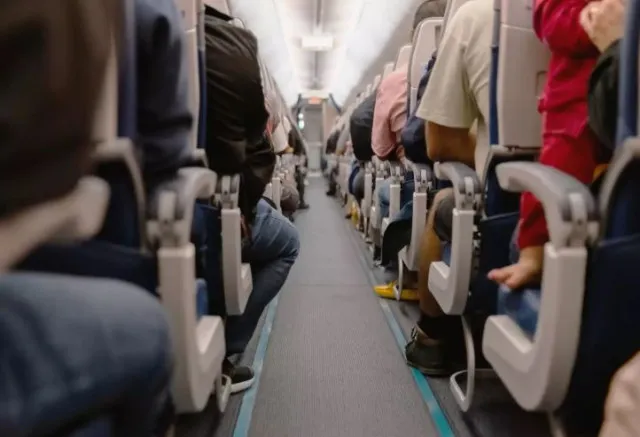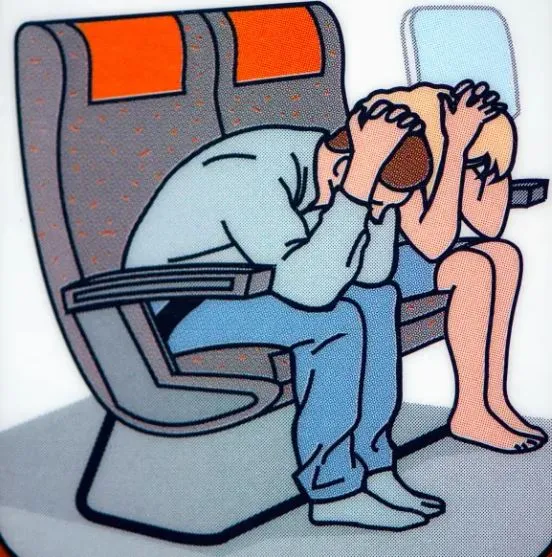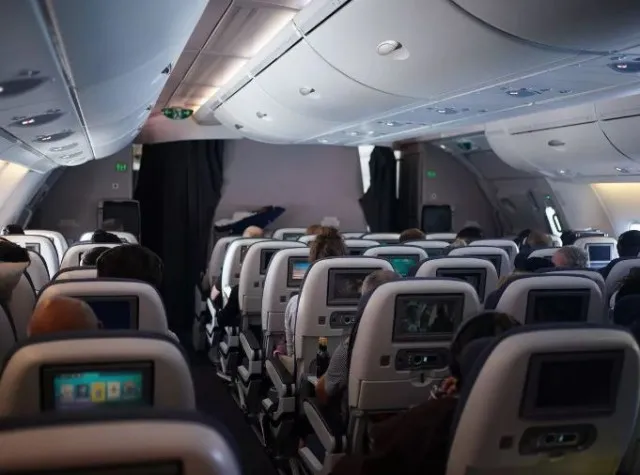Flying is one of the safest modes of transportation, but in the rare event of an emergency, every detail matters. Among the many safety instructions given to passengers, the brace position stands out as a critical measure. But why are passengers asked to assume this position during emergencies? Nick Eades, the world’s most experienced Boeing 747 pilot, provides valuable insights into the purpose and effectiveness of the brace position, debunking myths and explaining the science behind this life-saving posture.
What Is the Brace Position?

The brace position is a specific posture passengers are instructed to adopt during emergency landings or crashes. It typically involves leaning forward, placing your hands over your head or behind your neck, and keeping your feet flat on the floor. While the exact instructions may vary slightly based on the aircraft and seating arrangement, the goal is universal: to protect the most vulnerable parts of the body.
The seemingly simple position is carefully designed to reduce injuries, particularly to the head, neck, and upper body, during high-impact situations. When executed correctly, the brace position can significantly improve a passenger’s chances of survival.
The Science Behind the Brace Position
Nick Eades, with over 40 years of experience flying Boeing 747s, explains the rationale behind this safety measure. He likens the brace position to preventing whiplash in a car accident, emphasizing its role in minimizing trauma during an impact.
“What you’re trying to do is stop people breaking their necks in a big impact,” Eades explains. The position reduces the sudden forward motion of the head and neck, which can lead to fatal injuries. By tucking in and securing the body, passengers are less likely to suffer severe trauma, particularly to the spine and head. The design of the brace position is backed by extensive research, crash simulations, and real-life aviation studies.
How the Brace Position Protects Passengers
The brace position is a multi-faceted safety measure, offering protection to different parts of the body. Here’s how it works:
1. Protecting the Head and Neck
Leaning forward and covering the head reduces the risk of blunt force trauma. By limiting head movement, the brace position also minimizes the likelihood of neck injuries such as whiplash, which can occur when the head is thrown forward uncontrollably during an impact.
2. Shielding Against Flying Debris
In a crash, loose objects can become dangerous projectiles. The brace position protects the face and head by creating a shield with the arms or headrest, reducing the risk of injury from airborne debris.
3. Securing the Lower Body
Keeping feet flat on the floor and tucked against the seat in front prevents the legs from flailing or being crushed during an impact. This positioning helps reduce injuries to the legs, ankles, and feet, allowing passengers to evacuate more easily after a crash.
4. Safeguarding Internal Organs
The slight compression of the torso in the brace position helps protect vital organs from the force of impact, reducing the risk of severe internal injuries.
Debunking Myths About the Brace Position

Over the years, conspiracy theories and myths about the brace position have circulated, with one of the most notorious claims suggesting it is designed to ensure quick fatalities during crashes to reduce lawsuits. Nick Eades vehemently dismisses these baseless allegations as absurd and unfounded.
The sole purpose of the brace position is to enhance passenger safety. Every aspect of its design is rooted in scientific evidence and aimed at reducing the severity of injuries during emergencies. The idea that airlines would prioritize financial concerns over human lives undermines the rigorous safety protocols upheld by the aviation industry.
The Challenges of Communicating Safety Instructions
One of the key issues during emergencies is ensuring passengers understand and follow safety instructions, particularly on international flights. As Eades points out, the term “brace” itself can be confusing, especially for non-native English speakers. In the chaos of an emergency, shouting “brace” might not convey the urgency or clarity needed for passengers to respond effectively.
To address this challenge, airlines have refined their communication strategies. Cabin crews now rely on universally understood gestures and simple, clear phrases. Safety demonstrations and instructional videos are also designed to be highly visual, ensuring all passengers, regardless of language barriers, understand what to do in critical moments.
The Evolution of Safety Protocols

The aviation industry constantly evolves to enhance passenger safety. Decades of crash investigations and research have led to improvements in safety procedures, including the brace position. Eades recalls an incident in his career involving a landing gear malfunction, where the cabin crew’s repeated shouting of “brace” underscored the importance of clear communication during emergencies.
Today, airlines place greater emphasis on accessibility and inclusivity in their safety demonstrations. By prioritizing effective communication and continuous training, they aim to ensure passengers are prepared to respond appropriately in life-threatening situations.
Why You Should Pay Attention to Safety Demonstrations
Let’s be honest—most passengers zone out during pre-flight safety demonstrations. However, these instructions are crucial and could one day save your life. The brace position, in particular, is a scientifically proven measure that has been developed and refined to protect passengers in emergencies.
Taking a few moments to understand and remember these instructions can make all the difference. Whether it’s knowing how to assume the brace position or locating the nearest exit, these small details could significantly impact your chances of survival.
The Psychological Aspect of the Brace Position

While its primary purpose is physical protection, the brace position also offers psychological benefits. Adopting a prepared posture during an emergency can provide passengers with a sense of control and focus, reducing panic and improving overall survival outcomes.
Conclusion: A Simple Position That Saves Lives
The brace position is not just a routine instruction—it’s a life-saving measure rooted in science and decades of research. Designed to protect passengers from head, neck, and internal injuries, it plays a critical role in improving survival rates during emergencies. Experts like Nick Eades have debunked myths surrounding its purpose, emphasizing its sole intent: to save lives.
The next time you fly, take the safety demonstration seriously. Understand the brace position, locate your nearest exit, and stay aware of your surroundings. While emergencies are rare, being prepared can make all the difference when seconds count. In the air, as in life, preparation and knowledge are the ultimate safety nets.


